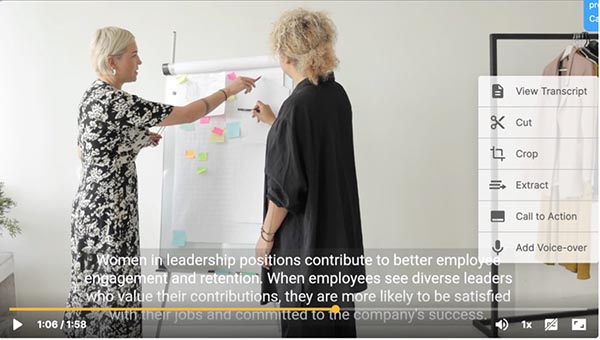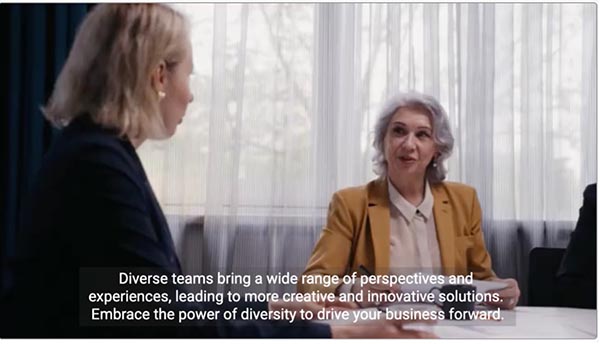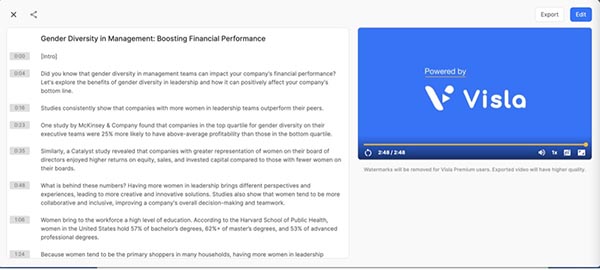We all know the power of video in marketing. We don’t need post the stats to make the point, but stats are always helpful. According to recent data:
- 78% of marketing professionals say videos have directly helped to increase sales, and 86% say that videos have increased traffic to their websites. (Wyzowl)
- People spend 2.6x more time on pages with video than without. (Brightcove)
- Videos on landing pages can increase conversion rates by up to 80%. (Unbounce)
But who has the time and money to invest in video production? The good news is, maybe you don’t have to. If AI can write your emails, finish your texts, and write your web copy, maybe it can create your videos, too. To some extent, it can. How well does it work?

Recently, we looked at seven different uses of artificial intelligence that printers can use in their businesses to increase their profitability. One of those uses was AI-generated video. We experimented with Visla, one of the AI platforms discussed in the webinar “5 AI Hacks to Crush Your Competition” (DirectMail2.0, 2023) covered back on August 31.
How Well Did Visla Do?
AI-generated video platforms do better with general content than they do highly technical content, so for the experiment, we chose the WhatTheyThink article, “Run the World: Gender Diversity Is Good for the Bottom Line” (WTT, August 9, 2023).
To create the video, we entered the hyperlink into the Visla dashboard and typed in a command for what type of video this should be. We used the following description: “This video explains to business owners and managers why gender diversity in their management teams helps them to be more profitable.”
We hit “generate,” and within a few minutes, the AI engine had pulled the text from the article it thought most relevant, paired it with what it determined to be appropriate stock images and video, and generated a 1:58-minute video, all based on the limit inputs provided.

In this video, you can see that Visla did, in fact, grab the main points from the article. However, absent the context and detail that a full article provides, those main points fall somewhat flat on their own.
(See final result here.)
The selection of videos initially selected by Visla was appropriate to the text. However, in order to export the video in the free version, Visla was required to swap out the selected videos with free stock. The result was some duplication of videos and some videos that were less than preferable. For example, the free version (viewable through the hyperlink above) includes an actor at :37 that is clearly not a woman in a corporate setting, as well as two actors at :29 that appear to be mother and daughter rather than businesswomen.
It was time to improve the script by adding detail to the text. In the Visla dashboard, each scene has its own box with the timer marker. We went into “edit,” chose the scene we wanted to edit, then replaced generic copy with specific examples and data points from the article. Once done, we hit the microphone, which updated the voiceover.

After editing, some of the scenes were now too text heavy, so we split them in two by using “add scene.” We cut the desired text from the existing scene, then pasted it into the new scene box. We hit “update voiceover,” then hit “update video.” Next, we hit “preview” to see the changes.

After a Little Tweaking…
If at first you don’t get it perfect, try, try again. After a few rounds of edits, for the purposes of the experiment, we called the script done.
As with the previous video, the video chosen by Visla to match the text was appropriate, but when it came time to export the video in the free version, Visla swapped out the selected video with free stock. The result, as before, contained questionable content, including the same video at :40 that, as before, is clearly not a woman in a corporate setting.
View the video here.
While we are unable to show you the non-free-stock versions of these videos without paying for the upgrade, the point is, AI is changing the game for marketing in ways we are only beginning to understand. Companies without technical or marketing expertise can now create professional-looking results without the technical expertise or financial investment that used to be required. Although the paid versions are clearly superior to the free versions, the costs for these platforms are quite reasonable. Visla, for example, is only $19 per month.
Here on What They Think, we’ve covered AI copywriting software (Jasper AI, ChatGPT, HoppyCopy), augmented reality creation (RealityBLU), and now AI video creation. Next up? AI-generated artwork. Stay tuned!















Discussion
By Louis De Nolf on Sep 21, 2023
Interesting, but I found it very repetitive. If not for the curiosity about it being AI-generated, I would not have watched this till the end. It's early days.
By Louis De Nolf on Sep 21, 2023
Question: would the video have been much better if you had the upgraded version? Or would it just have added some more snippets of women in business settings, rather than repeat a couple? Cause to my opinion, that would not have made it much more interesting
By Robert Godwin on Sep 21, 2023
AI generated videos and other content is an impressive use of search engine relevancy. There are many articles on how to create prompts that will deliver better targeted results. It is important to understand that none of the content is original. This point is not new to content creation. Movie studios re-used footage from prior films to reduce production costs. Burning buildings, car crashes, etc. become stock content. Many copy writers simply ‘massage’ existing marketing copy whether they source a competitor’s content or simply pull from technical documentation.
This AI movement is a democratization of creativity. The technology places assembly powers into the hands of the inexperienced. Maybe there will be a good product delivered, but more likely is a result that mimics everything else that has already been created. What happens when AI generative content is the majority of content that new AI pulls from? Copy of a copy of a copy. And we are then bored to the point of regarding these as so much noise.
Congress is working on copyright issues regarding the use of content AI pulls in. Amazon publishing is cracking down on AI generated books for just that reason. Printers for the past couple decades have had to warn clients that they will not print content that is not owned by the customer. Unless the AI program provides both sourcing of relevant content and attainment of publishing rights, it will remain on the outer fringes of usefulness.
By Heidi Tolliver-Walker on Sep 21, 2023
@Louis. You can create better videos for free, but if you want to export them without the watermark, then you need to upgrade. In the initial AI generation, the quality of the videos was somewhat better, and it didn't have the repetition that these do.
The value here, as I see it, is that AI creates a very good baseline that you can work from. With just a little extra time (and design skill, which I don't have), I would have created some charts from those studies I mentioned and swapped out some of the videos for them. I also would have taken the one or two lists in the script and put them into bullet point form, perhaps overlaying them on the video, rather than having them as running text below. Things like that.
With a little bit of skill and time, you could take these videos and upgrade them significantly, and that's the point. As I see it, AI video generation isn't going to eliminate the need for human intervention and creativity. It just makes it more accessible and speeds up the process — a lot. (As it does the process of copywriting; same issue. It can quickly give you a great base to work with. Then it takes a human writer to polish it up and customize it to what you need.)
AI did in a matter of minutes what it would have taken a human being hours to do with access to resources (professional stock video) that many printers / clients don't have. It gives them an "almost finished" product that they most likely DO have the skills to finish out.